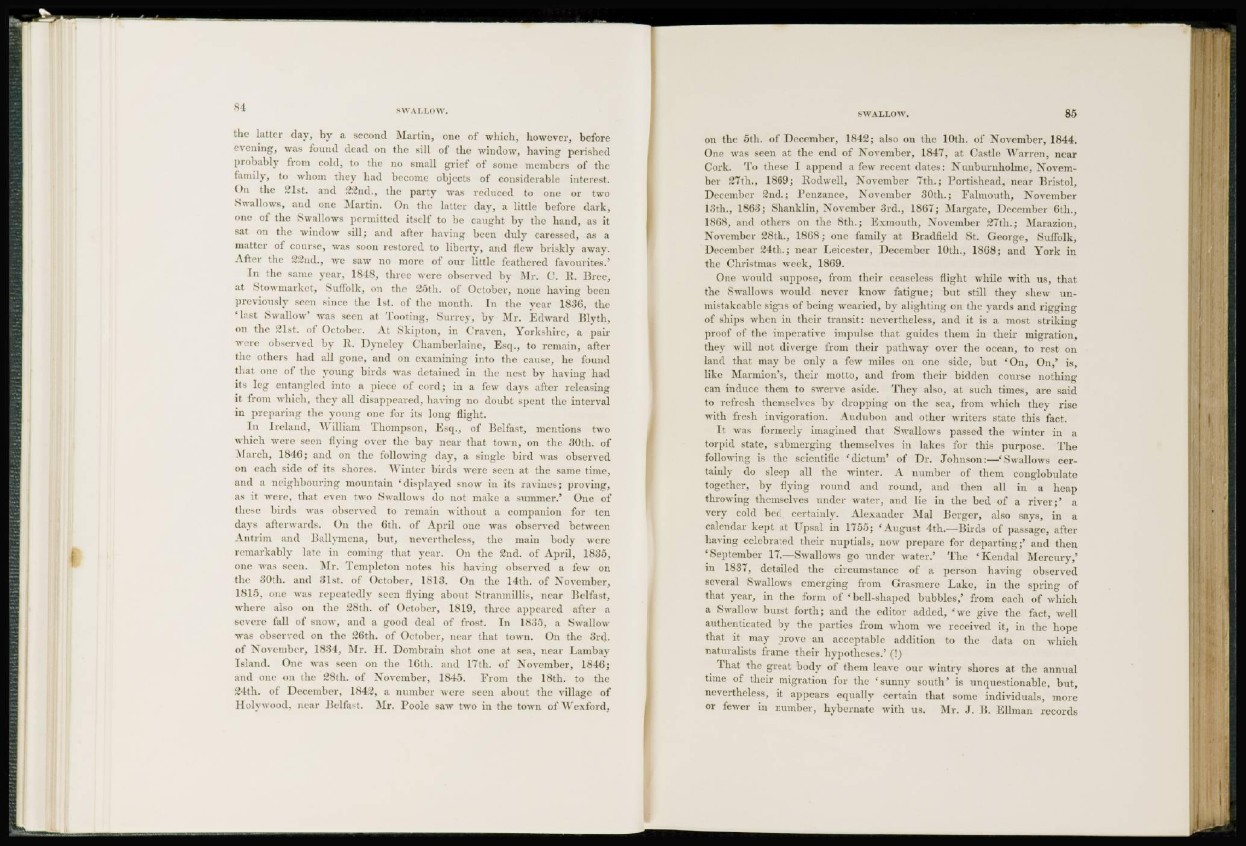
the latter day, by a second Martin, one of which, however, before
evening, was found dead on the sill of the window, having perished
probably from cold, to the no small grief of some members of the
family, to whom they had become objects of considerable interest.
On the 21st. and 22nd., the party was reduced to one or two
Swallows, and one Martin. On the latter day, a little before dark,
one of the Swallows permitted itself to be caught by the hand, as it
sat oa the window sill; and after having been duly caressed, as a
matter of course, was soon restored to liberty, and flew briskly away.
After the 22nd., we saw no more of our little feathered favourites.'
In the same year, 1848, three were observed by Mr. C. R. Bree,
at Stowmarket, Suffolk, on the 25th. of October, none having been
previously seen since the 1st. of the month. In the year 1836, the
'last Swallow' was seen at 'looting, Surrey, by Mr. Edward Blyth,
on the 21st. of October. At Skipton, in Craven, Yorkshire, a pair
were observed by R. Dyneloy Chamberlainc, Esq., to remain, after
the others had all gone, and on examining into the cause, he found
that one of the young birds was detained in the nest by having had
its leg entangled into a piece of cord; in a few days after releasing
it from which, they all disappeared, having no doubt spent the interval
in preparing the young one for its long flight.
In Ireland, William Thompson, Esq., of Belfast, mentions two
which were semi living oven- the bay near that town, on the 30th. of
March, 184G; and on the following day, a single bird was observed
on each side of its shores. Winter birds were seen at the same time,
and a neighbouring mountain 'displayed snow in its ravines; proving,
as it wore, that even two Swallows do not make a summer.' One of
these birds was observed to remain without a companion for ten
days afterwards. On the 6th. of April one was observed between
Antrim and Ballymena, but, nevertheless, the main body were
remarkably late in coming that year. On the 2nd. of April, 1835,
one was seen. Mr. Templcton notes his having observed a few on
the 30th. and 31st. of October, 1813. On tin- 14th. of November,
1815, one was repeatedly seen living about Stranmillis, near Belfast,
where also on the 28th. of October, 1819, three appeared after a
severe fall of snow, and a good deal of frost. In 1835, a Swallow
was observed on the 26th. of October, near that town. On the 3rd.
of November, 1834, Mr. H. Dombrain shot one at sea, near Lambay
Island. One was seen on the 16th. and 17th. of November, 1846;
and one on the 28th. of November, 1845. From the 18th. to the
24th. of December, 1842, a number were seen about the village of
llohwood. near Belfast. Mr. Toole saw two in the town of Wexford,
on the 5th. of December, 1842; also on the 10th. of November, 1844.
One was seen at the end of November, 1847, at Castle Warren, near
Cork. To these I append a few recent dates: Nunburnholmc, November
27th.. 1869; Rodwell, November 7th.; Portishead, near Bristol,
December 2nd.; l'enzance, November 30th.; Falmouth, November
13th., 1863; Shanklin, November 3rd., 1867; Margate, December 6th.,
1868, and others on the 8th.; Exmouth, November 27th.; Marazion,
November 28th., 1868; one family at Bradfield St. George, Suffolk,
December 24th.; near Leicester, December 10th., 1868; and York in
the Christmas week, 1869.
One would suppose, from their ceaseless night while with us, that
the Swallows would never know fatigue; but still they shew unmistakcable
signs of being wearied, by alighting on the yards and rigging
of ships when in their transit: nevertheless, and it is a most striking
proof of the imperative impulse that guides them in their migration,
they will not diverge from their pathway over the ocean, to rest on
land that may be only a few miles on one side, but 'On, On,' is,
like Marmion's, their motto, and from their bidden course nothing
can induce them to swerve aside. They also, at such times, are said
to refresh themselves by dropping on the sea, from which they rise
with fresh invigoration. Audubon and other writers state this fact.
It was formerly imagined that Swallows passed the winter in a
torpid state, submerging themselves in lakes for this purpose. The
following is the scientific 'dictum' of Dr. Johnson:—'Swallows certainly
do sleep all the winter. A number of them conglobulate
together, by flying round and round, and then all in a heap
throwing themselves under water, and lie in the bed of a river;* a
very cold bed certainly. Alexander Mai Berger, also says, in a
calendar kept at Upsal in 1755; 'August 4th.—Birds of passage, after
having celebrated their nuptials, now prepare for departing;' and then
'September 17.—Swallows go under water.* The 'Kendal Mercury,'
in 1837, detailed the circumstance of a person having observed
several Swallows emerging from Grasmcrc Lake, in the spring of
that year, in the form of 'bell-shaped bubbles,' from each of which
a Swallow burst forth; and the editor added, 'we give the fact, well
authenticated by the parties from whom we received it, in the hope
that it may prove an acceptable addition to the data on which
naturalists frame their hypotheses.* (!)
That the great body of them leave our wintry shores at the annual
time of their migration for the 'sunny south' is unquestionable, but,
nevertheless, it appears equally certain that some individuals, more
or fewer in number, hybernate with us. Mr. J. B. Ellman records